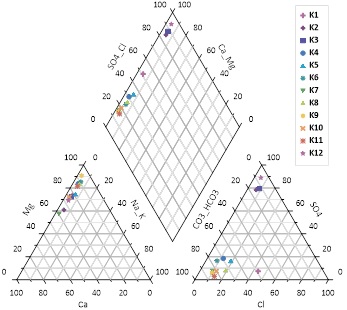
Hydrogeochemical Characteristics and Groundwater Quality Assessment of a Relatively-Pristine Agricultural Basin (Palas Basin)
Corresponding Author:
Filiz Dadaser-Celik
DOI Number https://doi.org/10.52924/QXOT934
Received: 21.11.202
Accepted 19.01.202
Published 26.01.202
Summary:
This study investigates the spatial and temporal changes in groundwater levels and quality in the Palas Basin, a relatively-pristine semi-arid agricultural basin in Türkiye. Although groundwater is solely used as irrigation and drinking-potable water resource throughout the basin, measurements regarding the dynamics and quality of groundwater were quite rare. The analyses were based on data collected from 12 water quality monitoring wells and 15 groundwater level monitoring wells during June 2019-May 2020. Water samples were analyzed for pH, electrical conductivity, temperature, nitrate, nitrite, ammonium, total nitrogen, total hardness, alkalinity, chloride, sulfate, phosphate, total organic carbon, calcium, magnesium, sodium, potassium, and arsenic. Data analyses included hydrogeochemical analysis and multivariate statistical analysis such as principal component analysis and cluster analyses. Results showed that water quality in the basin is mostly controlled by natural factors, however, anthropogenic impacts from agriculture activities were apparent in some regions. The basin shows significant changes in water levels throughout the year due to irrigation activities. The groundwater quality was classified as either Ca-Mg-HCO3 and Ca-Mg-SO4 type. In the majority of the basin, water quality was suitable for irrigation and drinking water uses, however, a few sampling sites had very high electrical conductivity, sulfate, nitrate, and arsenic levels. The high levels of nitrates were detected in areas, where agriculture is intense, indicating that agricultural activities might be affecting water quality. High sulfate, electrical conductivity, and arsenic levels could be related to the hydrogeological setting of the basin. This study showed that agricultural activities and natural factors were effective on the hydrochemical characteristics of Palas Basin.
Graphical Abstract:
